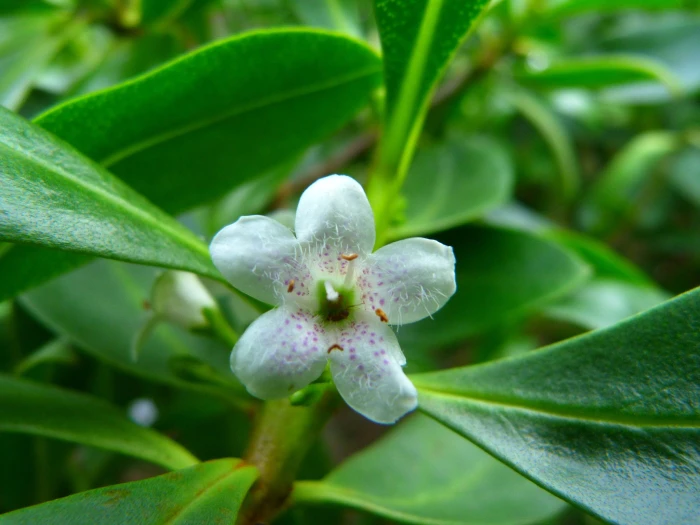Ngaio
(Myoporum laetum)
Ngaio (Myoporum laetum)
/
/

Zack Abbey
CC BY 4.0
Image By:
Zack Abbey
Recorded By:
Copyright:
CC BY 4.0
Copyright Notice:
Photo by: Zack Abbey | License Type: CC BY 4.0 | License URL: http://creativecommons.org/licenses/by/4.0/ | Rights Holder: Zack Abbey | Publisher: iNaturalist | Date Created: 2017-01-18T10:09:21-08:00 |












































































Estimated Native Range
Climate Requirements for Rahway, New Jersey
| This Plant | Your Site | Plant Suitability for Your Location | ||
|---|---|---|---|---|
| • Precipitation | 0" - 237" | 49" | Aquatic | Aquatic |
| • High Temp. | 58°F - 107°F | 86°F | Your summer temperatures are normal for this plant. | Excellent |
| • Low Temp. | 3°F - 82°F | 22°F | Your winter temperatures are normal for this plant | Excellent |
This plant may not grow well at your location - your precipitation is too high.
Summary
Myoporum laetum, commonly known as Ngaio or Mousehole Tree, is an evergreen tree or large shrub native to coastal areas and lowland forests in New Zealand. It typically grows to a height of 10 meters (30 ft) with a trunk up to 0.3 meters (1 ft) in diameter, or it can spread to as much as 4 meters (10 ft). The Ngaio tree has a distinctive dome-shaped canopy in its youth, which may become irregular as it matures due to branch breakage. The leaves are fleshy and bear oil glands that appear as small translucent spots. Its flowers are small, white with purple spots, and borne in clusters of 2 to 6 on stalks 7–15 millimeters (0.3–0.6 in) long, flowering from mid-spring to mid-summer. The flowers are somewhat showy and are followed by bright red, non-edible drupes 6–9 millimeters (0.2–0.4 in) long.
Ngaio trees are valued for their fast growth, tolerance to coastal conditions, and their ability to thrive in a variety of soil types. They are often used for shelterbelts, ornamental plantings, and reforestation projects. The tree’s dense foliage and quick growth make it suitable for creating privacy screens or hedges. Ngaio is also known for its resilience to salt spray, making it ideal for seaside gardens. It requires full sun to part shade and can tolerate low to medium water conditions, preferring soils with medium drainage. While it can be propagated from seed, semi-hardwood cuttings are also effective. Gardeners should be cautious as all parts of the plant are toxic if ingested, and the sap can cause skin irritation in some individuals.CC BY-SA 4.0
Ngaio trees are valued for their fast growth, tolerance to coastal conditions, and their ability to thrive in a variety of soil types. They are often used for shelterbelts, ornamental plantings, and reforestation projects. The tree’s dense foliage and quick growth make it suitable for creating privacy screens or hedges. Ngaio is also known for its resilience to salt spray, making it ideal for seaside gardens. It requires full sun to part shade and can tolerate low to medium water conditions, preferring soils with medium drainage. While it can be propagated from seed, semi-hardwood cuttings are also effective. Gardeners should be cautious as all parts of the plant are toxic if ingested, and the sap can cause skin irritation in some individuals.CC BY-SA 4.0
Plant Description
- Plant Type: Tree, Shrub
- Height: 20-30 feet
- Width: 10-20 feet
- Growth Rate: Moderate
- Flower Color: White
- Flowering Season: Spring
- Leaf Retention: Evergreen
Growth Requirements
- Sun: Full Sun, Part Shade
- Water: Low, Medium
- Drainage: Medium
Common Uses
Bee Garden, Butterfly Garden, Deer Resistant, Hedges, Low Maintenance
Natural Habitat
Coastal areas and lowland forests in New Zealand
Other Names
Common Names: New Zealand Manatoka, Nieu-Seelandse Manatoka, Ngaio
Scientific Names: Myoporum laetum, Myoporum crystallinum, Myoporum pubescens, Myoporum perforatum
GBIF Accepted Name: Myoporum laetum G.Forst.